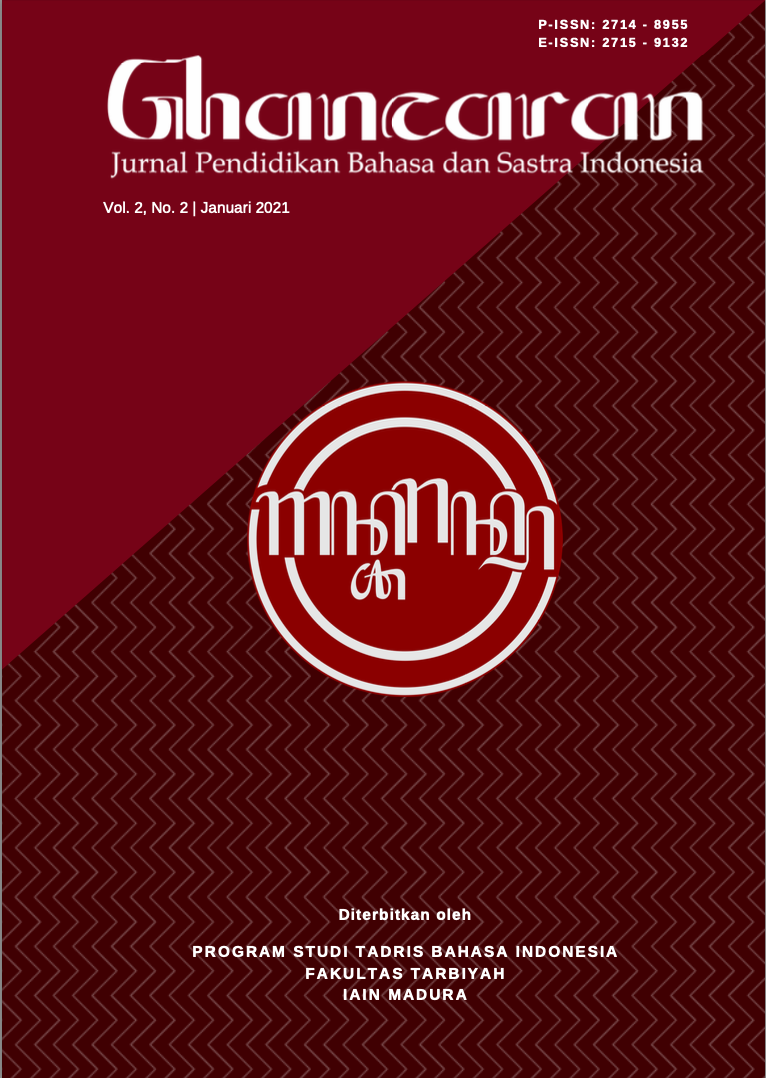RAGAM PERTANYAAN DAN TEKNIK BERTANYA PENGAJAR BIPA DALAM INTERAKSI PEMBELAJARAN DI KELAS
 Abstract views: 2150
,
Abstract views: 2150
,
 PDF downloads: 2204
PDF downloads: 2204
Abstract
Downloads
References
Astrid, A., Amrina, R. D., Desvitasari, D., Fitriani, U., & Shahab, A. (2019). The Power of Questioning: Teacher’s Questioning Strategies in the EFL Classrooms. Indonesian Research Journal in Education |IRJE|, 3(1), 91–106. https://doi.org/10.22437/irje.v3i1.6601
Al-Zahrani, M., & Al-Bargi, A. (2017). The Impact of Teacher Questioning on Creating Interaction in EFL:. English Language Teaching, 10(6), 135-150. doi:10.5539/elt.v10n6p135
Bilotserkovets, M., & Gubina, O. (2019). Target Language Teaching by Means of E-Learning: A Case Study. Romanian Journal for Multidimensional Education / Revista Romaneasca pentru Educatie Multidimensionala, 11(4), 17-29.
Cullen, R. (1998). Teacher Talk and The Classrom Context. ELT Journal Oxford University, 52(3).
Gall, M. D., & Rhody, T. (1987). Review of Research on Questioning Techniques. In W. W. Willen, Question, Questioning Techniques, and Effective Teaching (p. 30). National Education Association US.
Hall, J. K. (2001). Methods for Teaching Foreign Languages. Merrill Prentice-Hall.
Hall, J. K., & Verplaetse, L. S. (2000). Second and Foreign Language Learning Through Classroom Interaction. Lawrence Erlbaum Associates, Publishers.
Harmer, J. (2017). The Practice of English Language Teaching 4th Edition. Pearson Longman.
Kurtz, S. M. (2017). Learner-centred communication training. Oxford textbook for communication in oncology and palliative care. Oxford University Press.
Lemke, J. L. (1990). Talking science: Language, learning, and values. ERIC.
Pica, T. D. (1985). Making Input Comprehensible: Do Interactional Modifications Help? TESOL Sumer Meeting, Georgetown University. Georgetown University.
Qashoa, S. H. (2013). Effects of teacher question types and syntactic structures on EFL classroom interaction. The International Journal of Social Sciences, 7(1), 52-62.
Richards, J. &. (2001). Approaches and Methods in Language Teaching. Cambridge University Press.
Susanto, G. (2007). Kompetensi dan Profesionalisme Pengajar BIPA Ditinjau dari Sudut Pandang Pebelajar BIPA. Semiloka dan Konferensi Internasional BIPA. Jakarta.
Suyitno, I. (2004). Pengetahuan Dasar BIPA Pandangan Teoritis Belajar Bahasa. Grafika Indah.
Tafonao, T. (2018). Peranan Media Pembelajaran dalam Meningkatkan Minat Belajar Mahasiswa. Jurnal Komunikasi Pendidikan, 2(2), 103-114.
Walqui, A. (2006). Scaffolding Instruction for English Language Learners: A Conceptual Framework. International Journal of Bilingual Education and Bilingualism, 9(2), 159-180.
Walsh, S. (2013). Classroom discourse and teacher development. Edinburgh University Press.
Wrench, S. J. (2020). Communication, Affect, & Learning in the Classroom 4rd Edition. Creative Commons.
Yuqin, Z. &. (2010). A Study of Teacher Talk in Interaction in English Classes. Chinese Journal of Applied Linguistics, 33(2).
Zamahsari, G. K., Roffi’uddin, A. H., & Widodo, H. S. (2019). Implementasi Scaffolding dalam Pembelajaran BIPA di Kelas Pemula. Jurnal Pendidikan: Teori, Penelitian, dan Pengembangan, 4(1), 68-78.
Ghancaran: Jurnal Pendidikan Bahasa dan Sastra Indonesia uses an Open Access Policy under the Creative Commons Attribution-ShareAlike 4.0 International License. Authors publishing in this journal agree to the following terms:
- Ghancaran Journal holds the copyright and grants the journal rights for first publication with the work simultaneously licensed under a

The work is distributed under Creative Commons Attribution-ShareAlike 4.0 International License which allows others to share, copy, and redistribute the material in any media or format and adapt, remix, change, and develop the material even for commercial purposes, as long as it is stated credit and license derivative works under similar terms. - Authors may make additional contractual arrangements for non-exclusive distribution of the journal's published work version.
- Authors are permitted to post their work online (e.g., in institutional repositories or on their websites) before and during submission, as doing so may lead to productive exchange.



















